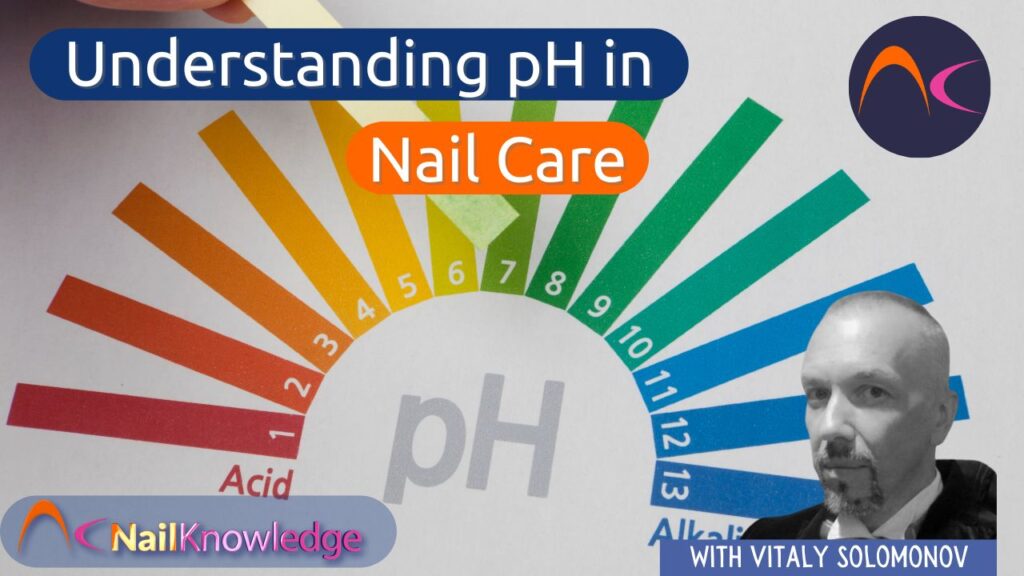El pH en el cuidado de las uñas
The concept of pH is widely discussed in beauty and nail care, but it’s often misunderstood. While pH plays a crucial role in the overall health of skin and hair, it’s important to clarify that nails themselves do not have a measurable pH value. Nails are solid structures made primarily of keratin, a protein, and pH applies only to aqueous (water-based) solutions. However, understanding how pH impacts the surrounding skin, nail products, and overall nail health is essential for nail technicians.
¿Qué es el pH en el cuidado de las uñas?
pH stands for “potential hydrogen” and measures the acidity or alkalinity of a substance on a scale from 0 to 14:
- Acidic: Un pH inferior a 7
- Neutral: Un pH de 7
- Alkaline (Basic): Un pH superior a 7
The skin surrounding the nails typically has a slightly acidic pH, usually between 4.5 and 5.5. This natural acidity serves as a protective barrier against bacteria, fungi, and other harmful microorganisms. Maintaining this balance is crucial for overall nail and skin health.
¿Tienen pH las uñas?
No, nails do not have a measurable pH value. Nails are composed of keratinised cells—solid, fibrous proteins that lack free hydrogen ions or water content necessary for pH measurement. While some articles suggest that nails have a “natural pH,” this is scientifically inaccurate. Instead, what can be influenced is the entorno de superficie of the nails due to external factors like water absorption, product application, or exposure to harsh chemicals.
¿Tienen las uñas un valor pH en el cuidado de las uñas?
While nails themselves don’t have a pH, the products applied to them—such as esmaltes de uñas, removers, gels, or creams—do have measurable pH values. These products can affect:
- Piel circundante: Los productos con niveles de pH extremos (demasiado ácidos o demasiado alcalinos) pueden alterar la barrera natural de la piel que rodea las uñas, provocando irritación o una mayor propensión a las infecciones.
- Nail Plate Condition: Prolonged exposure to certain products can alter the moisture balance within the nail plate, making it brittle or overly flexible.
- Rendimiento del producto: Nail products like primers or cleansers are often formulated with specific pH levels to optimise adhesion or removal processes.
Microorganismos
Our skin is full of all kinds of microorganisms, they help us stay healthy but sometimes they turn into monsters and start to attack us – but that’s a story for another day.
Nails are also surrounded by microorganisms and when we put artificial nail products on them the microorganisms that need oxygen to survive die – and the ones that function without oxygen stay alive.
Everyday on the socials we see what happens when our resident microorganisms become opportunistic and turn on us – pseudomonas aeruginosa is one of them.
An interesting fact: Men have a more moist layer of skin than women – testosterone is responsible for more oil and thicker skin and women have more estrogen which helps to maintain collagen and elasticity, removing any and or all of these skin layers as a ‘nail treatment’ and doing so will affect the pH balance of the skin in and around the nail unit.
Factores que influyen en la salud de las uñas
Rather than focusing on “nail pH,” professionals should prioritise factors that genuinely impact nail health:
- Niveles de hidratación: Las uñas pueden absorber agua de su entorno, lo que las ablanda temporalmente pero no cambia su composición inherente.
- Seguridad del producto: El uso de productos suaves tanto para las uñas como para la piel circundante ayuda a mantener la salud general (de la unidad ungueal).
- Salud de la piel: The cuticle area and surrounding skin play an important role in protecting nails from external damage. It’s important to maintain healthy skin or to improve it without exception.
- Técnicas de aplicación: Una preparación y unas técnicas de aplicación adecuadas garantizan la eficacia del producto al tiempo que minimizan los daños.
Consejos para técnicos de uñas
Prestar servicios eficaces de cuidado de las uñas:
- Utilice productos diseñados para uso profesional que sean suaves tanto para las uñas como para la piel circundante.
- Avoid prolonged exposure to harsh chemicals (e.g., acetone or acidic primers).
- Enseñar a los clientes a mantener unas uñas sanas protegiendo las cutículas y la piel circundante.
- Concéntrese en la hidratación recomendando cremas o aceites de manos que favorezcan la salud de la piel sin alterar su equilibrio natural.
Conclusión
While nails themselves do not have a measurable pH value due to their solid keratin structure, the concept of pH remains relevant in nail care through its impact on surrounding skin and product performance. By understanding how products interact with nails and skin, nail technicians can make informed choices that promote safety, health, and integrity for their clients.
Remember: it’s not about measuring “nail pH” but about ensuring that products work harmoniously with the body’s natural systems to maintain healthy nails and skin.
Este artículo revisado elimina cualquier afirmación engañosa sobre el pH natural de las uñas y conserva información útil sobre cómo el pH influye indirectamente en las prácticas de cuidado de las uñas a través de los productos y la salud de la piel circundante. Aporta claridad al tiempo que mantiene su tono educativo para los profesionales del sector de las uñas.


